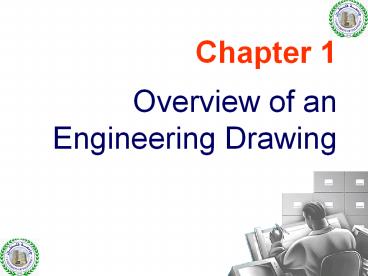Overview of an Engineering Drawing - PowerPoint PPT Presentation
1 / 57
Title:
Overview of an Engineering Drawing
Description:
Chapter 1 Overview of an Engineering Drawing GRAPHICS LANGUAGE Engineering Drawing Drawing Standard Introduction Drawing Sheet Traditional Drawing Tools Text on ... – PowerPoint PPT presentation
Number of Views:441
Avg rating:3.0/5.0
Title: Overview of an Engineering Drawing
1
Chapter 1 Overview of an Engineering Drawing
2
TOPICS
3
GRAPHICS LANGUAGE
4
Effectiveness of Graphics Language
1. Try to write a description of this object.
2. Test your written description by having
someone attempt to make a sketch from your
description.
You can easily understand that
The word languages are inadequate for describing
the size, shape and features completely as
well as concisely.
5
Composition of Graphic Language
Graphic language in engineering application
use lines to represent the surfaces, edges and
contoursof objects.
6
Freehand drawing The lines are sketched without
using instruments other than pencils and erasers.
7
Instrument drawing Instruments are used to draw
straight lines, circles, and curves concisely
and accurately. Thus, the drawings are usually
made to scale.
8
Computer drawing The drawings are usually made
by commercial software such as AutoCAD, solid
works etc.
9
Engineering Drawing
10
Elements of Engineering Drawing
Engineering drawing are made up of graphics
language and word language.
11
Basic Knowledge for Drafting
Word language
Graphics language
12
Drawing Standard
13
Introduction
Standards are set of rules that govern how
technicaldrawings are represented.
14
Standard Code
15
Partial List of Drawing Standards
???. 210 2520 ?????????????????? ????????????
???. 440 ?.1 2541 ??????????????????????? 1 ??????
???. 446 ?.4 2532 ????????????????????????????
?????????
???. 1473 2540 ?????????????????
?????????? ????????????????????????????? ???
??????????? ????????????? ???????????????
????? http//library.tisi.go.th/data/lib_resourc
es/pdf/catalog-online49/tis/02_ICS.pdf
16
Partial List of Drawing Standards
JIS Z 8311 Sizes and Format of Drawings
JIS Z 8312 Line Conventions
JIS Z 8313 Lettering
JIS Z 8314 Scales
JIS Z 8315 Projection methods
JIS Z 8316 Presentation of Views and Sections
JIS Z 8317 Dimensioning
17
Drawing Sheet
A4
Trimmed paper of a size A0 A4.
A3
Standard sheet size (JIS) A4 210 x 297 A3
297 x 420 A2 420 x 594 A1 594 x 841 A0 841
x 1189
A2
A1
(Dimensions in millimeters)
A0
18
1. Type X (A0A4)
2. Type Y (A4 only)
Drawing space
Drawing space
Border lines
Title block
Title block
19
Drawing Scales
Length, size
Scale is the ratio of the linear dimension of an
element of an object shown in the drawing to the
real linear dimension of the same element of the
object.
Size in drawing
Actual size
20
Drawing Scales
SCALE 11 for full size SCALE X1 for
enlargement scales (X gt 1) SCALE 1X for
reduction scales (X gt 1)
21
Basic Line Types
Name according to application
Types of Lines
Appearance
NOTE We will learn other types of line in later
chapters.
22
Meaning of Lines
Visible lines represent features that can be
seen in the current view
Hidden lines represent features that can not be
seen in the current view
Center line represents symmetry, path of
motion, centers of
circles, axis of axisymmetrical parts
Dimension and Extension lines indicate the sizes
and location of features
on a drawing
23
Example Line conventions in engineering drawing
24
Traditional Drawing Tools
25
DRAWING TOOLS
26
DRAWING TOOLS
1. T-Square
2. Triangles
27
DRAWING TOOLS
2H or HB for thick line
4H for thin line
3. Adhesive Tape
4. Pencils
28
DRAWING TOOLS
5. Sandpaper
6. Compass
29
DRAWING TOOLS
7. Pencil Eraser
8. Erasing Shield
30
DRAWING TOOLS
9. Circle Template
10. Tissue paper
31
DRAWING TOOLS
11. Sharpener
12. Clean paper
32
ABCDEFGHIJKLMNOPQRSTUVWXYZABCDEFGHIJKLMNOPQRSTUVWX
YZABCDEF
Lettering
ABCDEFGHIJKLMNOPQRSTUVWXYZABCDEFGHIJKLMNOPQRSTUVWX
YZABCDEF
33
Text on Drawings
Text on engineering drawing is used
Thus, it must be written with
34
Example
Placement of the text on drawing
35
Lettering Standard
ANSI Standard
This course
36
Basic Strokes
Straight
Slanted
Curved
Horizontal
Examples Application of basic stroke
4
5
I letter
1
A letter
B letter
1
2
1
6
3
3
2
37
Suggested Strokes Sequence
Upper-case letters Numerals
Straight line letters
Curved line letters
Curved line letters Numerals
38
Suggested Strokes Sequence
Lower-case letters
The text s body height is about 2/3 the height
of a capitalletter.
39
Stroke Sequence
T
F
L
I
E
H
40
Stroke Sequence
V
X
W
41
Stroke Sequence
Z
M
K
N
4
Y
A
42
Stroke Sequence
G
Q
C
O
43
Stroke Sequence
U
P
B
D
R
J
1
2
44
Stroke Sequence
7
5
45
Stroke Sequence
6
0
3
S
8
9
46
Stroke Sequence
i
l
47
Stroke Sequence
w
x
k
v
z
48
Stroke Sequence
y
f
t
j
r
49
Stroke Sequence
o
a
b
c
d
p
q
e
50
Stroke Sequence
n
m
h
g
u
s
51
Word Composition
Look at the same word having different spacing
between letters.
A) Non-uniform spacing
JIRAPONG
B) Uniform spacing
Which one is easier to read ?
52
Word Composition
JIRAPONG
Spacing
\ /
)(
Contour
General conclusions are
53
Space between Letters
1. Straight - Straight
3. Straight - Slant
2. Straight - Curve
4. Curve - Curve
54
Space between Letters
6. Slant - Slant
5. Curve - Slant
7. The letter L and T
55
Example Good and Poor Lettering
GOOD
Not uniform in style.
Not uniform in height.
Not uniformly vertical or inclined.
Not uniform in thickness of stroke.
Area between letters not uniform.
Area between words not uniform.
56
Sentence Composition
Leave the space between words equal to the
spacerequires for writing a letter O.
Example
ALL
DIMENSIONS
IN
O
O
O
ARE
MILLIMETERS
O
UNLESS
SPECIFIED.
O
OTHERWISE
57
End of Chapter 1 Overview of an Engineering
Drawing































